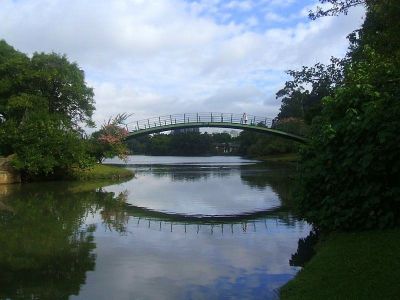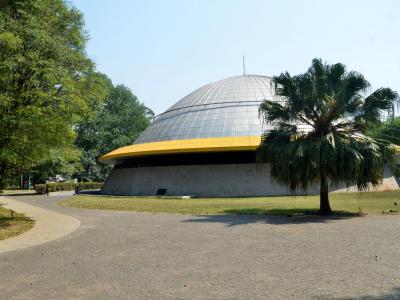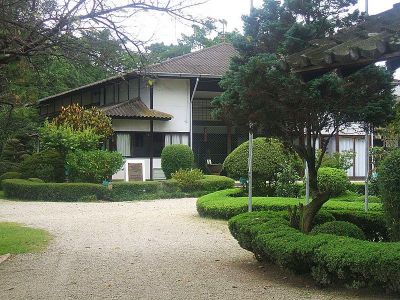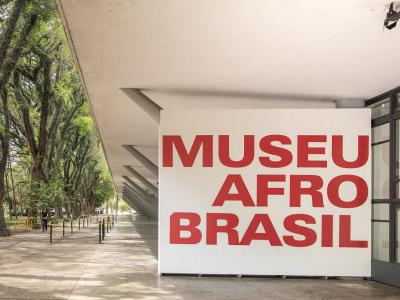
Ibirapuera Park
in the very heart of Sao Paulo, Ibirapuera Park is the city's most famous attraction. The park was designed by architect Oscar Niemeyer together with landscapist Roberto Burle Marx. It opened to the public on the 21st August, 1954. With a total space of 2 million square meters, the park features a beautiful landscape, filled with lakes, fountains, monuments, theaters, playgrounds, fitness areas, courts, museums and other attractions of architectural and cultural interest. Being the most visited park in Sao Paulo, Ibirapuera gathers in high season over 130 thousand visitors. The park also hosts several shows and events during the year, including São Paulo Fashion Week. Congresses and trade shows are held here regularly. Each weekend, visitors can enjoy live music shows delivered by different bands who come to the park for outdoor concerts. Take the following tour to discover the most popular landmarks of this magnificent place. Ibirapuera Park Footbridge
Ibirapuera Park Footbridge
This footbridge is the biggest of the bridges found in Ibirapuera Park. It is also one of the most picturesque and most photographed spots in the park. Made of cast iron, the bridge crosses over the Lake Ibirapuera, connecting two sides of the park. From there opens a great view of the faraway skyscrapers of Sao Paulo, which the visitors may enjoy amid the tranquility of the Ibirapuera park.
Ibirapuera Planetarium
(must see)
Ibirapuera Park is a wonderful place, abundant with museums, theaters and other places of cultural interest. Of these, particularly notable is the Planetarium. Designed by a group of architects (Eduardo Corona, Roberto G. Tibau and Antônio Carlos Pitombo), the Planetarium was inaugurated in 1957, to become the first of its kind institution in South America. It reopened in September 2006, after seven years of restoration works. The outline of the Planetarium resembles an alien spaceship, with a metal dome of 40ft in diameter, circled by a yellow wooden disk. In the course of the restoration, the firm Carl Zeiss installed in the showroom a large StarMaster projection screen. The showroom itself, seating 280, has also been designed by Zeiss. It allows the audience a much closer look at planets and stars. Visitors to the Planetarium are also invited to take part in different presentations organized regularly during weekends

Japanese Garden (Pavilhão Japonês)
If you wish to relax after a hard day's work or a tough workout in the park, but, at the same time, would like to experience something exotic and different, the Pavilhão Japonês (Japanese Garden) is an ideal place for that. A symbol of friendship between Brazil and Japan, the garden is known as the "jewel of the Ibirapuera Park", and is spread over 7500 square meters, encompassing an abundance of plants (including bonsai trees), ponds and small lakes, filled with goldfish as well as Shoin-style buildings, and offering a glimpse into the Japanese culture. The peculiarity of this park is in the fact that it was originally built in Japan, then taken apart, piece by piece, and reassembled in Sao Paulo in 1954, delivered as a gift for the fourth centenary of the city's foundation. The original Japanese materials - wood, volcanic rock, and Kyoto mud - of which the buildings and the garden have been made, facilitate a better cultural perception and entourage. The garden's central building, created by Sutemi Horiguti, a professor at the University of Tokyo, is a replica of the Katsura Palace, the former summer residence of the Emperor in Kyoto, Japan, built between 1620 and 1624. It is divided into a hall and several adjoining rooms that house a display of samurai clothes, pottery, ceramics, costumes, and sculptures from several Japanese imperial dynasties. Upstairs is the Tea Room, known as chashitsu, used for traditional tea ceremonies.

Museu Afro Brasil
Ibirapuera Park is a wonderful place, abundant with museums, theaters and other places of cultural interest. Of these, particularly notable is the Planetarium. Designed by a group of architects (Eduardo Corona, Roberto G. Tibau and Antônio Carlos Pitombo), the Planetarium was inaugurated in 1957, to become the first of its kind institution in South America. It reopened in September 2006, after seven years of restoration works. The outline of the Planetarium resembles an alien spaceship, with a metal dome of 40ft in diameter, circled by a yellow wooden disk. In the course of the restoration, the firm Carl Zeiss installed in the showroom a large StarMaster projection screen. The showroom itself, seating 280, has also been designed by Zeiss. It allows the audience a much closer look at planets and stars. Visitors to the Planetarium are also invited to take part in different presentations organized regularly during weekends

Japanese Garden (Pavilhão Japonês)
If you wish to relax after a hard day's work or a tough workout in the park, but, at the same time, would like to experience something exotic and different, the Pavilhão Japonês (Japanese Garden) is an ideal place for that. A symbol of friendship between Brazil and Japan, the garden is known as the "jewel of the Ibirapuera Park", and is spread over 7500 square meters, encompassing an abundance of plants (including bonsai trees), ponds and small lakes, filled with goldfish as well as Shoin-style buildings, and offering a glimpse into the Japanese culture. The peculiarity of this park is in the fact that it was originally built in Japan, then taken apart, piece by piece, and reassembled in Sao Paulo in 1954, delivered as a gift for the fourth centenary of the city's foundation. The original Japanese materials - wood, volcanic rock, and Kyoto mud - of which the buildings and the garden have been made, facilitate a better cultural perception and entourage. The garden's central building, created by Sutemi Horiguti, a professor at the University of Tokyo, is a replica of the Katsura Palace, the former summer residence of the Emperor in Kyoto, Japan, built between 1620 and 1624. It is divided into a hall and several adjoining rooms that house a display of samurai clothes, pottery, ceramics, costumes, and sculptures from several Japanese imperial dynasties. Upstairs is the Tea Room, known as chashitsu, used for traditional tea ceremonies.

Museu Afro Brasil
(must see)
Museu Afro-Brasil is a perfect place to enrich one's knowledge of the African-Brazilian community and history. Representing six major themes (Africa, Work and Slavery, Sacred and Profane, Afro-Brazilian Religions, History and Memory, and Art), the collections feature more than 3000 exhibits, which have been gathered over the course of 20 years, and comprise religious artifacts, pieces of art from Africa, books and various written sources on the history of Brazilian slavery. The museum outlines the important contribution made by black Brazilians into the national culture. It forms part of the Manoel da Nóbrega Pavilion, which spreads over an area of 11,000 square meters.
Museu Afro-Brasil is a perfect place to enrich one's knowledge of the African-Brazilian community and history. Representing six major themes (Africa, Work and Slavery, Sacred and Profane, Afro-Brazilian Religions, History and Memory, and Art), the collections feature more than 3000 exhibits, which have been gathered over the course of 20 years, and comprise religious artifacts, pieces of art from Africa, books and various written sources on the history of Brazilian slavery. The museum outlines the important contribution made by black Brazilians into the national culture. It forms part of the Manoel da Nóbrega Pavilion, which spreads over an area of 11,000 square meters.
Comments
Post a Comment